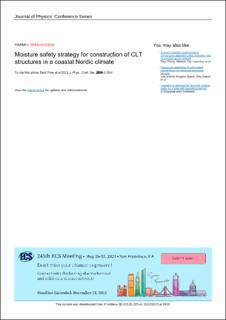| dc.contributor.author | Time, Berit | |
| dc.contributor.author | Andenæs, Erlend | |
| dc.contributor.author | Karlsen, Trygve | |
| dc.contributor.author | Geving, Stig | |
| dc.contributor.author | Kvande, Tore | |
| dc.date.accessioned | 2023-12-20T08:39:39Z | |
| dc.date.available | 2023-12-20T08:39:39Z | |
| dc.date.created | 2023-12-15T10:04:49Z | |
| dc.date.issued | 2023 | |
| dc.identifier.citation | Journal of Physics: Conference Series (JPCS). 2023, 2654 . | en_US |
| dc.identifier.issn | 1742-6588 | |
| dc.identifier.uri | https://hdl.handle.net/11250/3108309 | |
| dc.description.abstract | To reduce the carbon impact of new buildings, wood is seeing increased use as a structural material. Cross-laminated timber (CLT) and glue-laminated wood (glulam) elements allow the construction of multi-storey buildings. However, wood is vulnerable to moisture, especially when naked wood is exposed to weather during the construction process. This paper presents the moisture strategy employed during the construction of a four-storey CLT/glulam building in Trondheim, Norway. The building was constructed without the use of a weather-protective tent, requiring alternative protective measures. The construction of the main structure was scheduled to be as short as possible. Local protective measures were employed to protect the structure from rain and free water was removed after rain events. The project was closely supervised by the client, with particular care for moisture control. Moisture was regularly measured at 50 points throughout the building. No wooden surfaces were encapsulated until a wood moisture content below 15 weight-% was measured. The performance of the moisture strategy was evaluated using measurements of wood moisture, indoor climate, airtightness, and visual inspections. The wood moisture content quickly decreased as the building envelope was assembled, indicating that drying was well facilitated. In the first year after construction, gaps between the flooring and baseboards were observed, suggesting that the wooden elements have experienced some shrinkage. The moisture safety strategy is deemed to have been generally successful. The overall experiences were important in the development of new recommendations in the SINTEF Building Research Design Guides for CLT structures. | en_US |
| dc.language.iso | eng | en_US |
| dc.publisher | IOP Publishing Ltd. | en_US |
| dc.rights | Navngivelse 4.0 Internasjonal | * |
| dc.rights.uri | http://creativecommons.org/licenses/by/4.0/deed.no | * |
| dc.title | Moisture safety strategy for construction of CLT structures in a coastal Nordic climate | en_US |
| dc.type | Peer reviewed | en_US |
| dc.type | Journal article | en_US |
| dc.description.version | publishedVersion | en_US |
| dc.subject.nsi | VDP::Teknologi: 500 | en_US |
| dc.source.pagenumber | 10 | en_US |
| dc.source.volume | 2654 | en_US |
| dc.source.journal | Journal of Physics: Conference Series (JPCS) | en_US |
| dc.identifier.doi | 10.1088/1742-6596/2654/1/012041 | |
| dc.identifier.cristin | 2213999 | |
| dc.relation.project | Norges forskningsråd: 237859 | en_US |
| dc.source.articlenumber | 012041 | en_US |
| cristin.ispublished | true | |
| cristin.fulltext | original | |
| cristin.qualitycode | 1 | |

